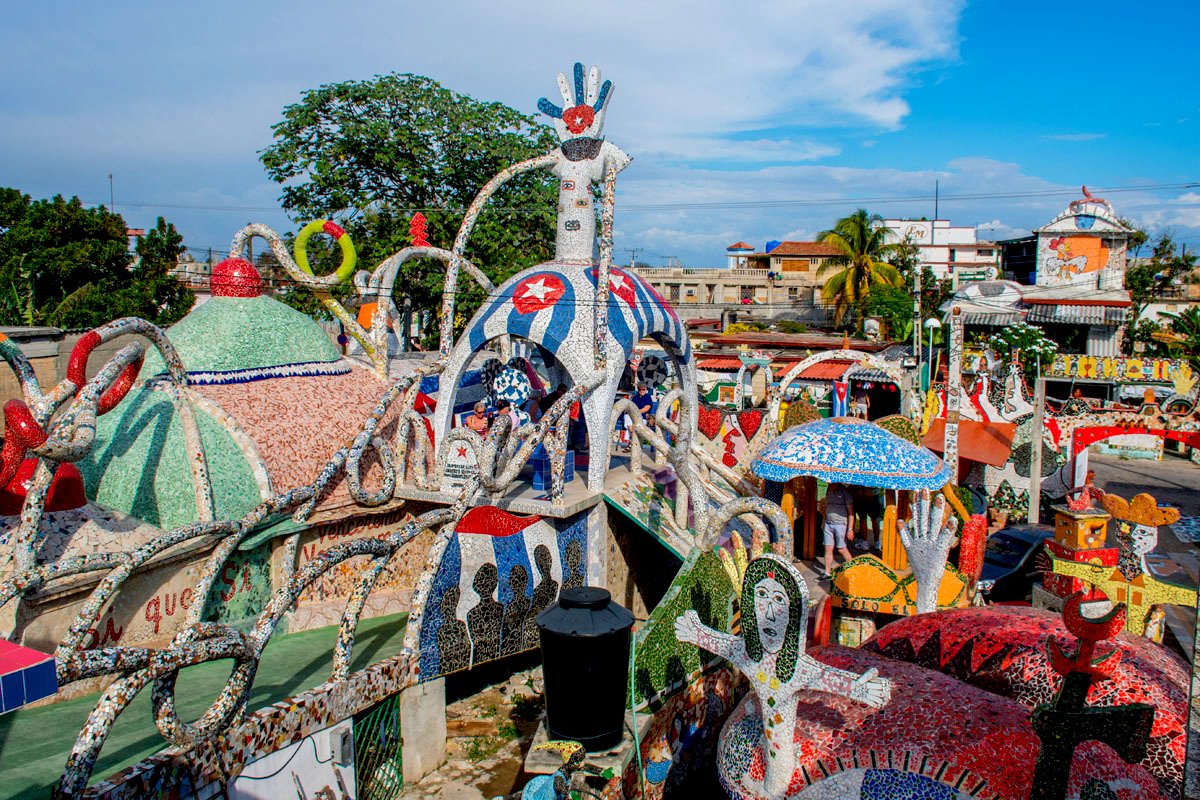When the opportunity arose for me to go back to Cuba, I jumped on it! Like most Americans, this country fascinates me with its beauty and brightness. From the cars, the buildings, and the streets of Havana, nothing can express Cuban culture more than vivid painted colors.
The colors used in Cuban art are especially vivid, with artists using vibrant hues to express their view of rural life. But life in Cuba is very limited so one must improvise with what is available. Raw Art (also know as Outside Art) is made with whatever materials an artist can find on hand. It could be an old 1950s Chevy or colorful broken ceramic tiles. Colorful art is scattered around every corner in Havana, transforming buildings and neighborhoods into giant public works of art.
Step Inside Jose Fuster’s Fusterlandia
Our first stop is a bright and colorful wonderland known as Fusterlandia. Located west of Havana in Jaimanitas, where Cuban artist José Fuster, has turned his home neighborhood into living art. Fuster’s initial centerpiece was started by decorating his home with mosaic fragments. His artwork quickly filled his yard, overflowing to surrounding homes, street signs and bus stops.. After four decades, more than 80 murals overlay the homes and domes in this small community.
Fuster’s work has transformed him into one of the most influential and celebrated artists in Cuba. He graduated from Havana’s Art Instructor’s School in the mid-60’s and then continued his education in Europe. The experience lead him to admire the work of Pablo Picasso, Constatin Brancusi, and Antoni Gaudi, which undoubtedly stroked kaleidoscopic dreams at home in Cuba.
If you are heading to Cuba’s Avenida 5ta, you may have the opportunity to meet the artist, known as the “Picasso of the Caribbean”. If you are lucky, he may be around to tell you firsthand about his work. Making a tour of his home has made it possible for the community to grow through mosaic tiles and decorated glass. Fusterlandia is probably the most visited art space on the island. It is a free project supported by tourist donations and art gallery sales. Whether you are an art lover, an Instagrammer, or just interested in cool stuff, Fusterlandia has something for all.
Fuster is considered the “Cuban Picasso”
Welcome to the infamous Callejón de Hamel
Tucked away in Centro Havana lies a narrow alley known for its colorful street murals and unique sculptures. This project has interesting displays of recycled items such as bathtubs, water pumps and bicycles. From the moment you step through the entry arches you will find the most unusual items turned into works of art.
Havana’s Callejón de Hamel (or Hamel alley) is the product of artist Salvadore Gonzáles Escalona. The alley began in 1990 with the creation of his first Hamel street mural. Today this two-block artistic alley way is famous for its colorful murals that pays homage to Afro-Cuban religion and culture. And if you want to return home with some culture, there are some shops for purchasing paintings and hand carved religious sculptures.
Hamel alley may seem like a gallery, but it is a street like any other in Havana. You can enter the area for free and walk along the street to view the murals or stop for a mojito at an open-air bar. And if you find yourself free on Sundays, the street comes alive with rumba music and dancing from 12 pm until late afternoon.

Hamel Gallery
Street art around every corner in Havana!
My quest continues with an ordinary stroll through Havana Vieja. You cannot escape the street art, which is seen with each step of your journey. Every street has a story to tell, and each building has a colorful message. Like a treasure map, I found many unseen pictures of Havana – pure, beautiful, and raw.
Just when you think the city could not get any more colorful, it does! Rundown buildings and decaying walls serve as a new canvas for urban street artists. One of the most striking works I found is at the front doors of Hostal Casa Vieja. Here you will find a purple and orange iconic gorilla smoking a cigar! A popular graffiti artist recognized as “Noé-Two”, is renowned for his portraits of a gorilla called King Yaoundé. For a very long time this artist built his reputation on the streets, but nowadays Noé-Two has many graffiti inspired paintings in fine art galleries. He unique way of combining graffiti with canvas wall paint has identified him as an influential figure in the graffiti movement.
If you are a true lover of graffiti, I suggest you wander the streets of Havana slowly. Keep your eyes open to sections of doorways, alleys, and cobblestone streets. Any typical street scene could uncover a hidden gem of street art.
`` Noé-Two, the Godfather of Graffiti ``
“Do You Know What Is Love”
There are infinite reasons to fall in love with the colors of Cuba. But if you want to see the real beauty behind the photos, you should book a tour. I recommend taking a guided art tour from Airbnb. This should be perfect for you and a group of friends to split the cost. But if you are traveling solo this is a great opportunity to meet other US travelers.
Of course, this is just a suggestion to add to your Havana, Cuba experience. But in between your images of classic cars, cigars and mojitos, take some time to explore this enchanted city. I promise it will make your trip even more unforgettable!














